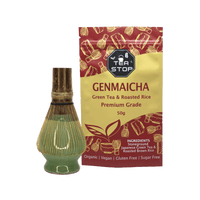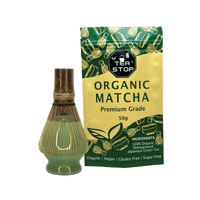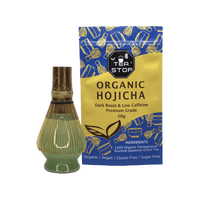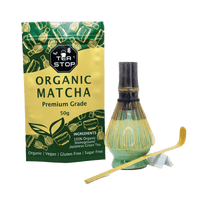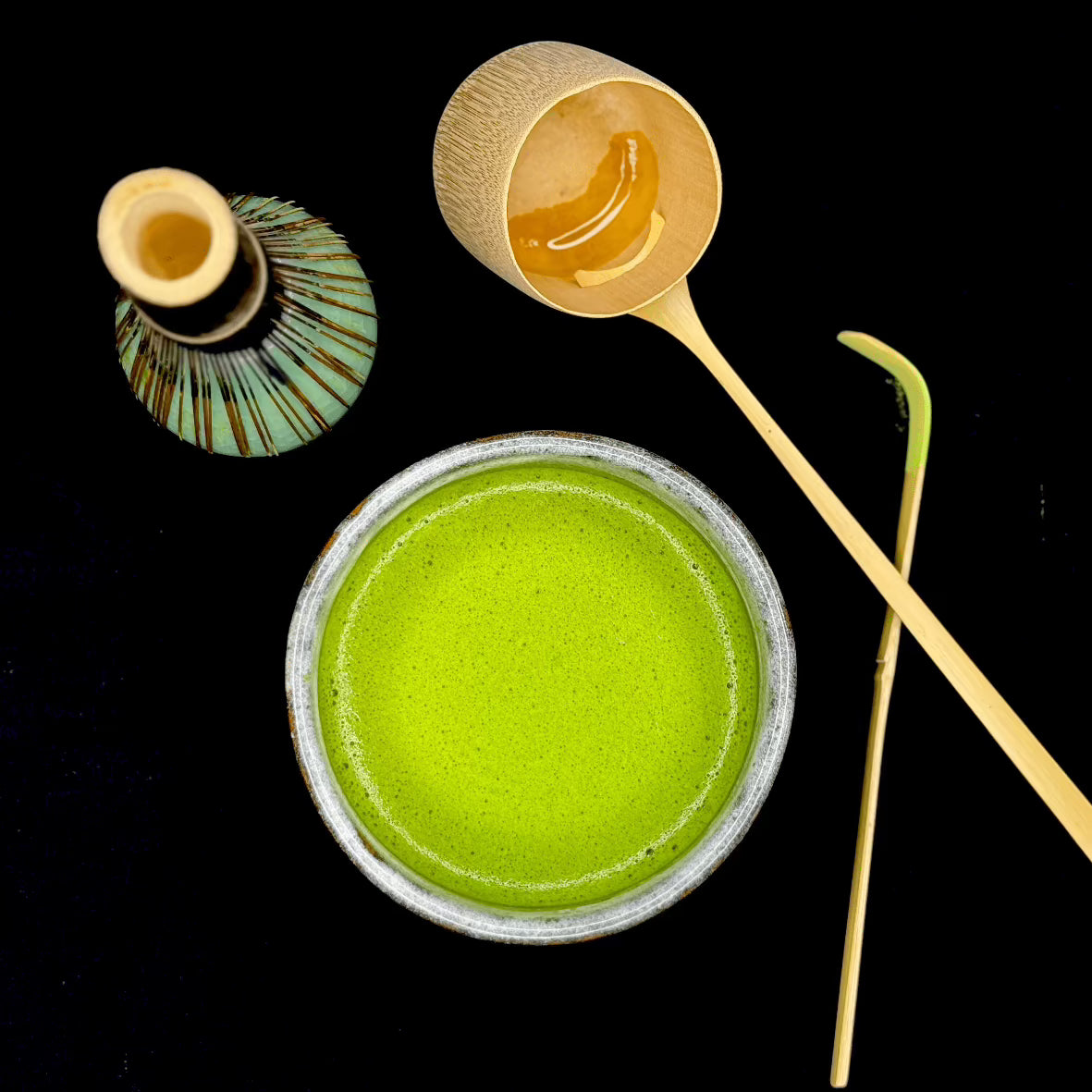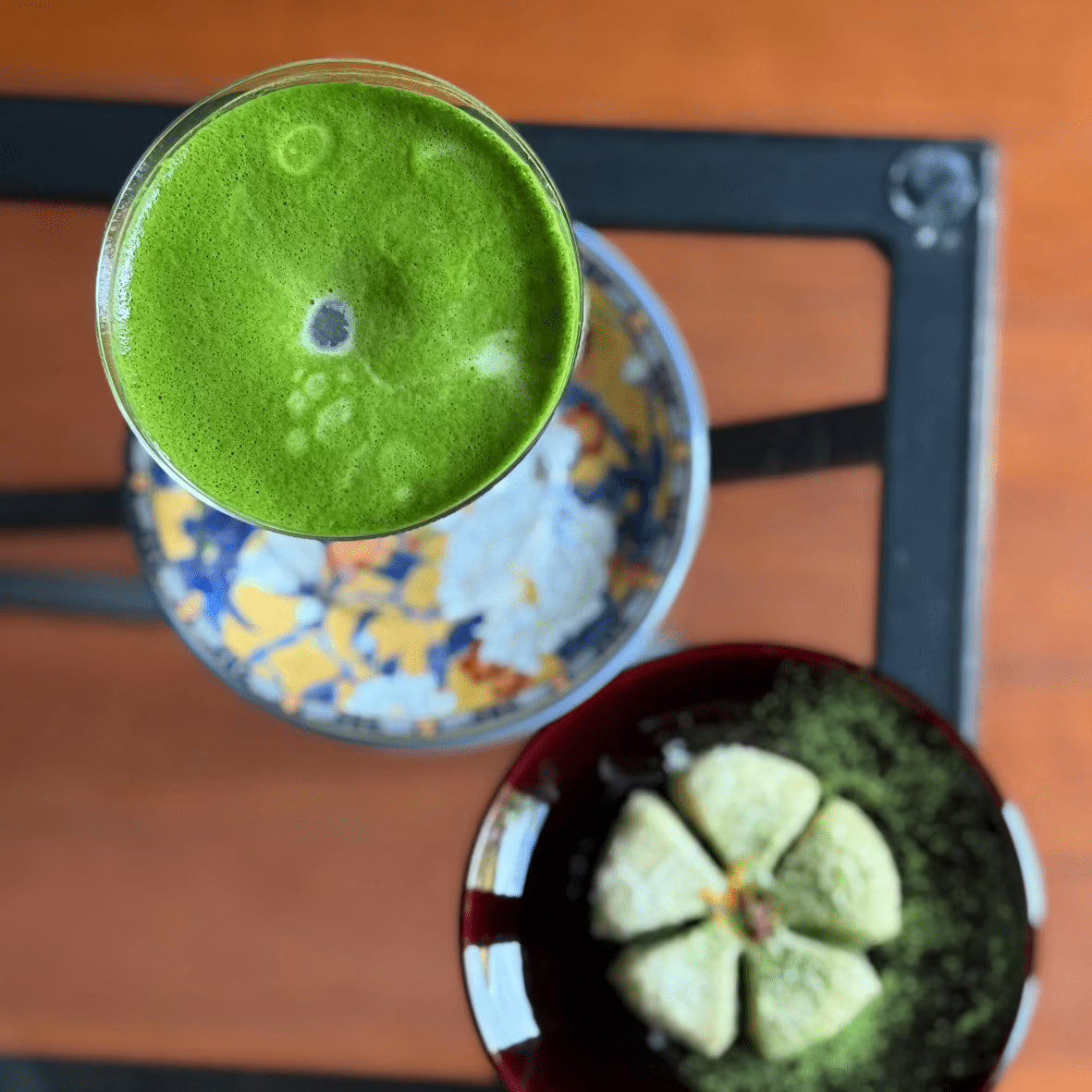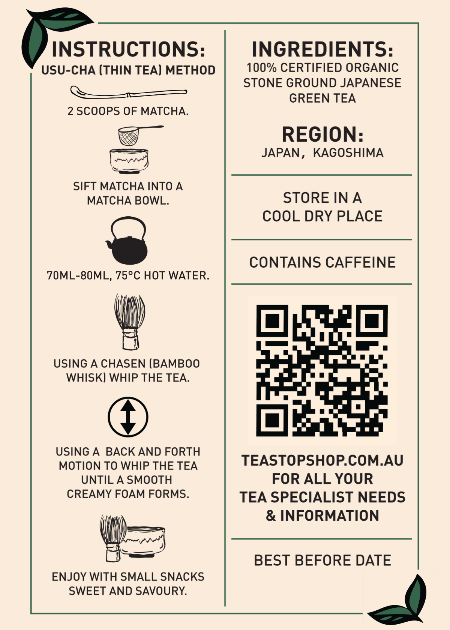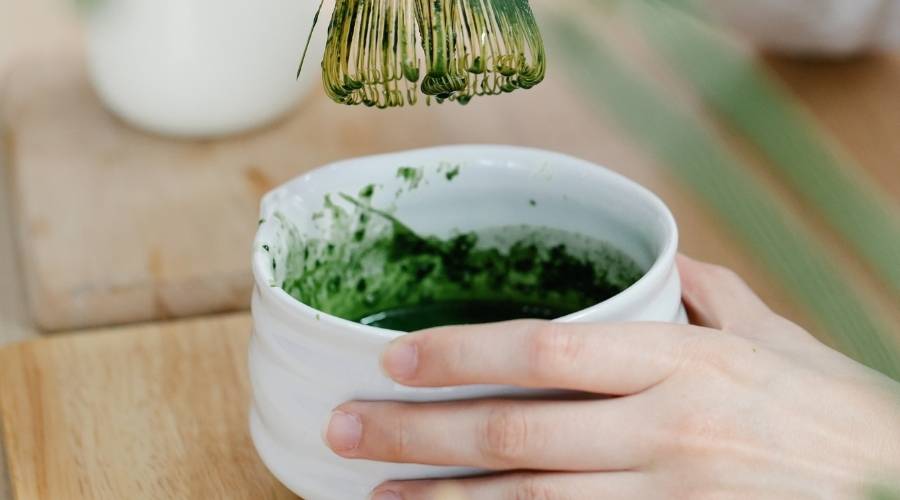
How to Make Matcha at Home: Step-by-Step with Tools You Need
Share
Matcha tea is a special type of green tea that offers a unique experience. Unlike regular green teas, matcha is made from finely ground leaves that are grown in the shade. This process enhances the flavor and nutritional profile of the tea, making it even more beneficial for your health.
Preparing matcha at home is an opportunity to slow down and be present. By using specific tools like the chasen (bamboo whisk) and chawan (tea bowl), you not only honor tradition but also enhance the sensory experience. These authentic tools help create the perfect froth and texture, bringing out the rich flavor of matcha.
Making matcha tea is easy:
- Sift high-quality matcha powder for a smooth result.
- Pour in warm water (not boiling).
- Whisk vigorously in an "M" motion until a light foam forms on top.
This mindful process turns an ordinary cup of tea into a soothing ritual that shows gratitude for nature's gifts.

The Essential Matcha Tools You Need
To make matcha, you need to know about the tools that are important for preparing it. Each tool has a specific purpose and adds to the experience of making this traditional Japanese tea.
1. Chawan (Matcha Bowl)
This bowl is used for both whisking and serving matcha. Its wide shape allows you to whisk vigorously, ensuring the tea is well mixed and frothy.
2. Chasen (Matcha Whisk)
Made from bamboo, the chasen is designed to froth the matcha tea and create a smooth texture. Its fine bristles help break up clumps and mix the powder evenly with water.
3. Chashaku (Matcha Scoop)
A slender bamboo scoop is used to measure out precise amounts of matcha powder. The chashaku ensures you use just the right quantity for a perfect cup of tea.
4. Hishaku (Ladle)
This bamboo ladle is traditionally used to transfer hot water into the matcha bowl. It adds elegance to each step of the tea-making process.
5. Kusenaoshi (Whisk Holder)
A practical tool for maintaining the shape of the chasen when not in use. Keeping your whisk in good condition ensures it lasts longer and remains effective.
6. Chakoshi (Tea Strainer)
Before whisking, using a fine mesh chakoshi helps remove any lumps from the matcha powder, resulting in a smoother texture and enhanced flavor.
7. Natsume (Tea Caddy)
Storing your matcha powder in a natsume helps preserve its freshness and potency. This container is designed to protect against moisture and light, keeping your matcha ready for use.
Knowing about these tools makes you appreciate the process of making matcha even more, combining mindfulness with tradition for an authentic experience at home.

Step-by-Step Guide to Making Matcha at Home
1. Preparing Your Workspace and Measuring Matcha Powder
Creating the perfect cup of matcha begins with a clean and organized workspace. This sets the stage for a mindful and intentional tea-making experience.
A clutter-free environment helps in focusing on the ritual of preparing matcha, ensuring that each step is carried out with precision. Gather all necessary tools before starting: chawan (matcha bowl), chasen (whisk), chashaku (scoop), chakoshi (tea strainer), and natsume (tea caddy). Having everything within reach streamlines the process and enhances the overall experience.
Proper Measurement Techniques
Accurate measurement of matcha powder is crucial for achieving the perfect taste and consistency. The traditional tool used for this purpose is the chashaku, a bamboo scoop designed specifically for handling matcha powder.
- Using the Chashaku:
- Hold the chashaku horizontally while scooping.
- To measure, scoop approximately 1-2 grams of matcha powder per serving, which usually translates to about two heaping scoops using the chashaku. Adjust based on your taste preference.
Ensuring precise measurement not only affects the flavor but also impacts the texture of your matcha. Too little powder might result in a weak brew, while too much could make it overly bitter.
Embrace this moment as an opportunity to practice mindfulness. Focus on each scoop, appreciating the vibrant green color and fine texture of premium organic matcha. This step lays the foundation for a harmonious tea-making ritual that honors centuries-old traditions.
By dedicating time to prepare your workspace and measure matcha correctly, you cultivate a space that supports tranquility and focus, enhancing both your tea-making practice and overall enjoyment.
2. Sifting Matcha Powder and Heating Water to the Correct Temperature
The next step in making matcha at home is sifting your matcha powder and preparing water at the ideal temperature—a practice that gently honors both tradition and taste.
Sifting Matcha Powder
Using a chakoshi (fine mesh tea strainer) is a small but significant ritual. Fresh matcha powder can clump due to its fine, delicate texture. Sifting ensures:
- A Silky, Lump-Free Consistency: Whisking sifted matcha creates a smooth, creamy bowl with no gritty residue.
- Enhanced Aroma and Flavor: The act of sifting releases subtle vegetal notes, amplifying both fragrance and taste.
- Aesthetically Pleasing Presentation: Fine, aerated powder blends more easily, resulting in a vibrant green froth that’s visually inviting.
Simply place the chakoshi over your chawan (matcha bowl), add measured matcha powder, and gently tap or use a spoon to press it through.
Heating Water for Matcha Tea
Water temperature has a profound effect on both the flavor profile and nutritional value of matcha. Using a hishaku (bamboo ladle) adds mindfulness to the process while helping you pour just the right amount.
- Ideal Brewing Range: For matcha, aim for 70–80°C (158–176°F). This preserves delicate amino acids and prevents bitterness.
- Mindful Pouring: Ladling water with care invites presence to each movement—a practice cherished in the Japanese tea ceremony.
Bringing awareness to these steps—sifting and heating—sets the stage for whisking and enjoying your matcha with intention.
3. Whisking Matcha with Chasen and Serving It with Elegance
A mindful approach to making matcha at home centres on the whisking process—a moment where both technique and intention come together. The chasen (bamboo whisk) is the heart of this ritual, designed specifically to coax out the vibrant, frothy texture that defines quality matcha.
How to Whisk Matcha Using a Chasen:
- Pour the pre-measured, sifted matcha powder into your chawan.
- Add hot water at the ideal temperature (70–80°C).
- Hold the chawan steady with one hand while gripping the chasen lightly in the other.
- Begin whisking briskly in an “M” or “W” motion—not a circular stir—using just your wrist. This technique aerates the tea, producing a lively green foam on top and blending powder without clumps.
- Pause when you see a delicate layer of froth, smooth and bright.
Serving matcha is as much about visual harmony as it is about taste. The chawan is chosen not only for its function but also for its aesthetic qualities—texture, colour, and balance all matter. Traditionally, the bowl’s most beautiful side is turned toward your guest or yourself before sipping. This gesture honours both the tea and those present, reflecting Japanese values of respect and mindfulness.
The artistry of preparing workspace for matcha making continues through every step: from measuring matcha powder precisely to choosing tools that elevate both flavour and presentation. Each element supports a mindful pause in your day—an invitation to savour simplicity and beauty in a single cup.
Experiencing the Ritual of Enjoying Traditional Matcha Tea Ceremony Style
Stepping into the world of the traditional matcha tea ceremony invites a deeper connection with both self and surroundings. Every gesture, from the way water is poured to how the chawan is presented, is infused with mindfulness and intention. This ritual is not only about savoring matcha’s vibrant flavor—it’s a moment to pause, breathe, and appreciate the craftsmanship behind each tool.
1. Setting the Scene
The atmosphere often features quietude, natural light, and elements that honor nature—perhaps a sprig of fresh greenery or a simple linen cloth.
2. Respect for Tools
Each matcha tool—chawan, chasen, chashaku—receives care and gratitude, reflecting centuries-old traditions. Handling these implements with mindfulness enhances their meaning.
3. Presence in Each Sip
Guided by principles of harmony (wa), respect (kei), purity (sei), and tranquility (jaku), participants engage all senses: watching the emerald froth swirl, inhaling subtle aromas, and feeling warmth between hands.
These moments foster calmness and unity, reminding us that making matcha is as much about nourishing the spirit as it is about preparing tea.
Conclusion
Making matcha at home is an opportunity to slow down and appreciate the rich history of Japanese culture and the natural world. By using carefully selected matcha tools that are both practical and aesthetically pleasing, you can turn each bowl of matcha into a nourishing experience for yourself.
At Tea Stop Shop, we offer a wide selection of certified organic teas and genuine accessories that are specifically chosen to enhance your everyday routine. Visit our website to explore our handpicked collection and learn how high-quality ingredients and mindful preparation can bring peace, focus, and a hint of sophistication to every sip of matcha.

